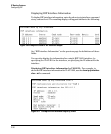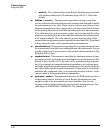
IP Routing Features
Configuring IRDP
The display shows if any routes, identified by the IP Address and Mask fields
are being restricted from redistribution. The restrict filters are configured by
the router rip restrict command described on page 3-31.
Configuring IRDP
The ICMP Router Discovery Protocol (IRDP) is used by ProCurve routing
switches to advertise the IP addresses of their router interfaces to directly
attached hosts. IRDP is disabled by default. You can enable the feature on a
global basis or on an individual VLAN interface basis.
When IRDP is enabled, the routing switch periodically sends Router Adver-
tisement messages out the IP interfaces on which the feature is enabled. The
messages advertise the routing switch's IP addresses to directly attached
hosts who listen for the messages. In addition, hosts can be configured to
query the routing switch for the information by sending Router Solicitation
messages.
Some types of hosts use the Router Solicitation messages to discover their
default gateway. When IRDP is enabled on the ProCurve routing switch, the
routing switch responds to the Router Solicitation messages. Some clients
interpret this response to mean that the routing switch is the default gateway.
If another router is actually the default gateway for these clients, leave IRDP
disabled on the ProCurve routing switch.
IRDP uses the following parameters. If you enable IRDP on individual VLAN
interfaces, you can configure these parameters on an individual VLAN inter-
face basis.
■ Packet type - The routing switch can send Router Advertisement
messages as IP broadcasts or as IP multicasts addressed to IP multicast
group 224.0.0.1. The default packet type is IP broadcast.
■ Hold time - Each Router Advertisement message contains a hold time
value. This value specifies the maximum about of time the host should
consider an advertisement to be valid until a newer advertisement arrives.
When a new advertisement arrives, the hold time is reset. The hold time
is always longer than the maximum advertisement interval. Therefore, if
the hold time for an advertisement expires, the host can reasonably
conclude that the router interface that sent the advertisement is no longer
available. The default hold time is three times the maximum message
interval.
3-40


















